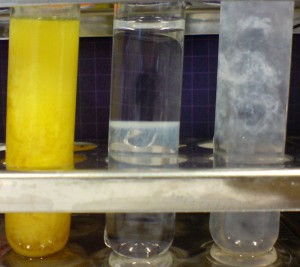Playlist
Show Playlist
Hide Playlist
Redox Reactions – Other Ionic Reactions
-
Slides 02 Chemistry Advanced Le Gresley.pdf
-
Download Lecture Overview
00:01 Right. Let’s move on to a practical application of some of the ionic chemistry that we discussed in the previous module. RedOx reactions are by far the most important types of reactions that you’ll come across. They involve the transfer of electrons from one species to another. Oxidation is defined as the loss of electrons. So, this would be, for example, let’s say, sodium, which is in group 1 as an element, would be oxidised when it lost its single outer shell electron. 00:36 A reduction is defined as a gain of electrons. Let us take fluorine. When it, in order to complete its outer shell, takes on a single electron, it would be considered to be reduced. 00:49 Sometimes an easy way to remember this is by the mnemonic, oil rig. Oxidation is loss, reduction is gain. Oxidation and reduction must occur simultaneously since, of course, the electrons must go somewhere; you don’t lose them, there is conservation of matter. So, let’s have a look at one example - the reaction of iron with a solution of copper sulphate. It is an example of an oxidation reduction reaction or a RedOx reaction. The equation for this is given below on our board. 01:21 Iron, as a solid, reacts with a solution of copper sulphate. Note, aq means it is in water. 01:29 And this results in the formation of a solution of iron sulphate and solid copper is then precipitated out. Let’s look at this in more detail. What do we actually mean? The net ionic equation, if we isolate it, shows that we are losing two electrons from the iron which we’re going to add to the copper ion, 2+, to form solid copper. So, in this scenario, iron or Fe is lost of two electrons or deprived of two electrons which results in the formation of Fe2+ cation. 02:10 The copper cation, which is already in solution, is reduced, gain in two electrons and can be converted from its 2+ cation to its oxidation state zero element. 02:24 And of course, this would… reaction would be visible because copper, as an element, is insoluble in water and would precipitate out.
About the Lecture
The lecture Redox Reactions – Other Ionic Reactions by Adam Le Gresley, PhD is from the course Ionic Chemistry.
Included Quiz Questions
Which of the following is NOT an example of a redox reaction that occurs in everyday life?
- Corrosion of gold and platinum jewelry in the dark
- Combustion of petroleum
- Corrosion of exposed metal
- Decay of wood
- The electron transport chain in living cells
Which of the following is NOT a correct statement regarding the metal displacement phenomenon?
- A metal atom in a compound form or solution form does not get displaced by an atom of another metal.
- After adding magnesium metal to a solution of copper sulfate, the blue color of the solution disappears.
- After adding an iron nail to a solution of copper sulfate, the color of the solution changes from blue to light green and reddish-brown deposits of copper metal form on the iron nail.
- The order of reactivity, from most reactive to least reactive, is: K > Na > Ca > Mg > Al > Zn > Fe > Cu > Ag > Au.
- Due to their low reactivity, gold and platinum exist in their pure elemental forms in nature.
Customer reviews
5,0 of 5 stars
| 5 Stars |
|
5 |
| 4 Stars |
|
0 |
| 3 Stars |
|
0 |
| 2 Stars |
|
0 |
| 1 Star |
|
0 |




